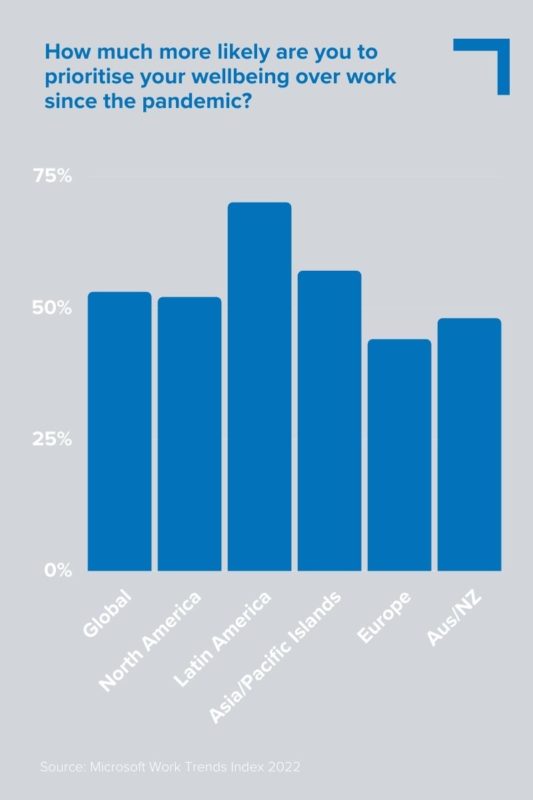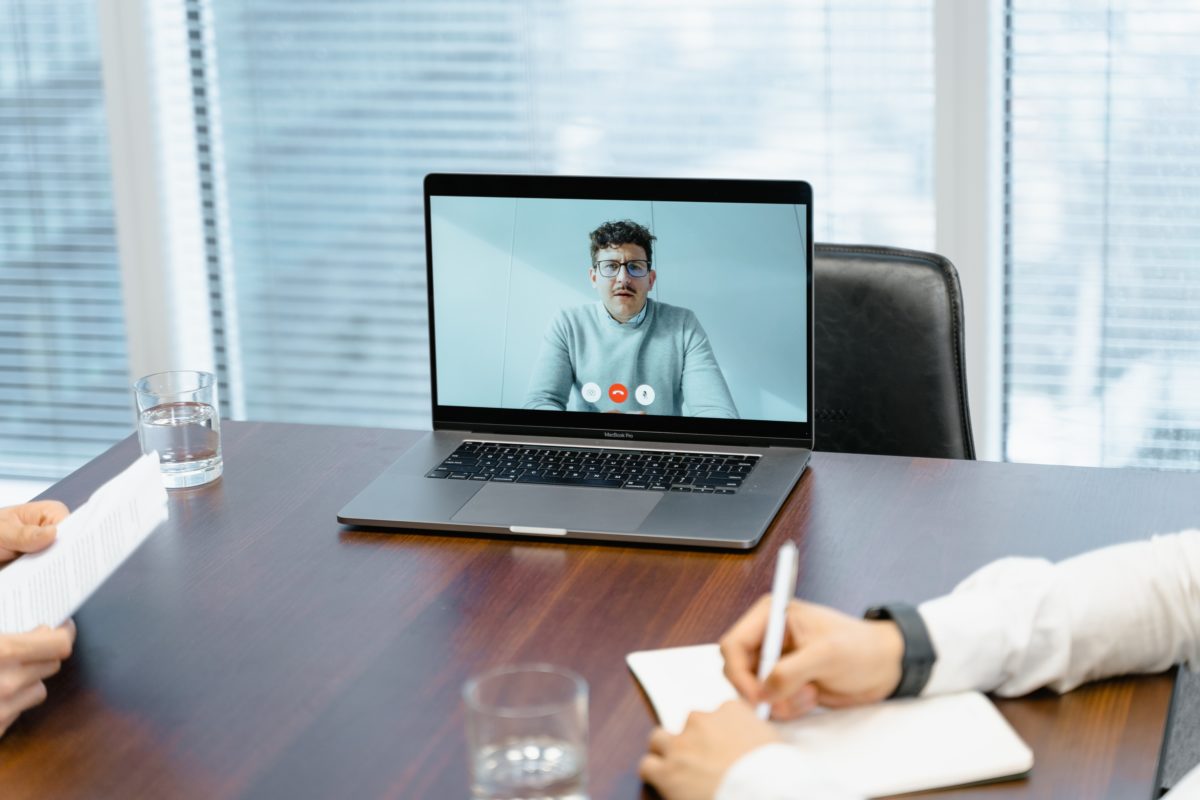Microsoft’s latest Work Trends Index reveals a new ‘worth it’ equation that employers need to consider when designing hybrid work experiences.
I was speaking with a friend the other day who said to me, “I might work from home tomorrow. I’ve heard it’s going to be cold.” We both laughed. Just a few years ago, the idea of not going into the office just because it was cold would seem ludicrous.
Now, it seems the smallest things deter hybrid workers from going into the workplace – we don’t want to face the traffic (Australians spend the equivalent of six work weeks per year commuting), we don’t want to be distracted by the office hubbub, or we simply don’t feel in the mood to be around people.
Essentially, we need a pretty good reason to don our work attire and get ourselves into the office.
Microsoft’s recent Annual Work Trend Index report backs this up, with 38 per cent of global respondents stating it’s not clear when or why they should come into the office.
“The collective experience of the past two years has left a lasting imprint, fundamentally changing how we define the role of work in our lives,” the report states.
In fact, 53 per cent of the 31,000 respondents, who were interviewed in Jan-Feb this year, stated they’re now more likely to prioritise their health and wellbeing over work than they were prior to the pandemic. (See graph below for country-by-country breakdown).
“We’ve already moved in the direction of looking after the whole person when you consider the benefits that many organisations offer, such as parental leave,” says Tony Tran, Lead People Scientist at Culture Amp.
“As work and life blend together, employees are going to expect their employers to also look after [their] wellbeing in other stressful moments in their lives…. like a death in the family, divorce or financial problems. I think the increased focus on wellbeing… is going to be the norm for organisations that want to attract talent.”

These new expectations, paired with more employers trialing hybrid work models, has given rise to what Microsoft is calling the ‘worth it’ equation. That is, what are you doing to make coming into the office feel valuable, exciting and meaningful for your people?
Not got time to read the whole article? Here are some key points:
-
- 38 per cent of employees in Microsoft’s latest Work Trends Index struggle to know when and why they should come into work – introducing a ‘worth it’ equation that employers need to respond to.
- 53 per cent of people prioritise their personal lives over work since the pandemic
- We should think about employee engagement as ’employee experience’, as engagement isn’t the only success metric businesses need to capture.
- Employers should create hybrid guidelines, such as a meeting etiquette info-sheet, to ensure hybrid work is inclusive.
- 74 per cent of managers don’t feel they have the resources or influence to incite the changes their teams want.
- 60 per cent of hybrid workers and 56 per cent of remote workers feel they have fewer work friends since working from home.
- 38 per cent of employees in Microsoft’s latest Work Trends Index struggle to know when and why they should come into work – introducing a ‘worth it’ equation that employers need to respond to.
Addressing the “worth it” equation
What do employees feel makes their work experience ‘worth it’? The report’s respondents rated the following things as “very important”:
-
- A positive work culture (46 per cent)
- Mental health and wellbeing benefits (42 per cent)
- A sense of meaning/purpose (40 per cent)
- Flexible hours (38 per cent)
Pay was also important to all respondents and Gen Z employees called out positive feedback and recognition for their work as being important. None of these findings will feel particularly groundbreaking; people have been calling for all these things prior to the pandemic. But where fresh thinking is required is in how employers deliver on these expectations in a hybrid work environment.
Tran suggests the answer lies in broadening out our definition of employee engagement to instead think about the employee experience.
“We need to think about employee engagement a little differently and treat it more like we do customer experience (CX) and user experience (UX),” he says.
Both CX and UX underwent a transition from being just about aesthetics and usability to being a tool to drive certain behaviours. Tran sees employee experience taking a similar path.
“In user experience, the ultimate goal is to create a positive experience for the user, but also to drive behaviours that are good for the company. ‘User error’ is a bad word in UX design because if the user makes a mistake that’s usually because you designed it poorly. If you’re finding that a lot of your employees aren’t engaged or aren’t [exhibiting] behaviours critical to the success of the organisation then maybe the design of the employee experience is off.”
The reason this could be occurring, Tran suggests, is because employers aren’t taking time to redesign processes for hybrid work.
“Employers need to be intentional about how they utilise space… The office used to be a place with computers and desks, but most office workers saw how they could easily do that at home. So the office now needs to serve a useful purpose that the home can’t serve.
“I have people in my team who ask me, ‘Do I need to come into the office?’ and if I can’t come up with a logical reason then they probably don’t need to.”
Creating hybrid-friendly cultures requires what Microsoft calls “radical intentionality” and an experimental mindset. It suggests playing around with different models, such as Team Tuesdays, offsite events that bring remote employees together or in-person hours from 12-2pm for a few days each week.
Smart employers will be making decisions that benefit both them and their people. For example, Tran shares the example of a company he worked with that made the decision to move its office closer to where the majority of its staff lived, cutting their commutes by half an hour each way. While that was a big decision to make, it was a tick in the ‘worth it’ column for its people.
“This organisation did something else really clever to get people back into the office. They needed to stress test their new office, with the WIFI and things like that. Instead of saying, ‘We need people to come in’, they threw an office party. While everyone was there having fun they’d say, ‘Oh, by the way. While you’re all here can we just test the WIFI?’ That was a win-win situation.”
Effective hybrid work practices
When making adjustments to processes for a hybrid work culture, consider actions that increase inclusion.
Meetings are an obvious starting point. Forty three per cent of remote workers felt excluded from meetings, Microsoft found. To remedy this, you could do things like invest in camera software that zooms in on the participant who is talking during a meeting around a boardroom table, giving the virtual attendees the feeling of being in the room.

Microsoft created a new set of norms for hybrid work cultures. Part of this involved creating a hybrid meeting etiquette list that’s displayed in all physical and virtual meeting rooms for its 18,000 staff to access. It includes tips such as:
-
- Join the video call before you start pre-meeting chit chat, so everyone can contribute to the social elements of a meeting.
- Include an agenda and a meeting moderator in every meeting.
- Record all meetings and include live transcriptions.
- Use the ‘raise hand’ feature so everyone can contribute equally.
- Be intentional about inviting virtual attendees to offer input.
There are also some big-picture issues to keep in mind.
“We need to think about the impact of remote work on career progression,” says Tran.
“If you’re working from home and your manager isn’t able to see your work, they might be less inclined to promote you because your achievements aren’t as visible. At performance evaluation time they’ll tend to recall what’s easiest to remember, and that’s likely to be the achievement of the people they see more often. Because of this, it’s critical that we find ways to increase the visibility of individuals’ achievements.”
(Read HRM’s article on proximity bias here).
Empowering managers
Another interesting finding from Microsoft’s report is that 74 per cent of managers don’t feel they have the resources or influence to incite the changes their teams want to see.
In other words, managers very much get the new value proposition that they need to deliver on to meet employee expectations, but they feel they’re getting stuck at the senior leadership level. In fact, over half of managers surveyed felt their leaders were out of touch with employees.
A clear example of this is in the mandate for people to return to the office. Fifty per cent of employers told Microsoft they were planning to force people back into the office in a full-time capacity, despite 80 per cent of employees reporting that their productivity levels are just as good, if not better, when they work from home.
This finding echoes that of other recently released reports, such as PwC’s deep dive into the employee value proposition and the Access Group’s research into rising employee autonomy. Both demonstrate either leadership’s lack of interest in making changes or misconceptions about their people’s work experience.
“We need to think about employee engagement a little differently and treat it more like we do customer experience and user experience.” – Tony Tran, Lead People Scientist, Culture Amp
Does this tell us that it’s perhaps time to give certain leaders a reality check? Perhaps. And so, HR professionals could encourage their leaders to decentralise decision-making power to empower managers to act on their team’s unique needs. As HRM has previously explored, this can generate positive outcomes for the business and give employees a sense of control over their work experience.
Whatever you do, don’t leave leadership issues to fester, as they can have serious flow-on effects to other parts of the organisation, says Tran.
“Our own research at Culture Amp shows that if an employee disagrees with a question about how effective their managers are, they’re less likely to be engaged. We actually see a 25%+ difference in motivation for those that were neutral or disagreed with these questions around manager effectiveness.”
With all this in mind, you might be thinking about establishing some new guidelines for hybrid work, but where to begin?
“I’d start by understanding and locking down why you care about engagement and why other key stakeholders across the organisation might care about it,” says Tran.
“If you’re going to change culture, you can’t do it on your own, so you need to establish a shared goal. Then define what an engaged culture looks like – what kinds of behaviours are important? Next, find out what experiences your employees need to have in order to facilitate those behaviours… An employee engagement survey might help you figure that out. Then you break down those experiences and focus on what’s most important.”
How are you developing strong hybrid work cultures in your organisation? Let us know in the comment section.
Want some tips for creating a more effective hybrid work culture? AHRI’s short course has got you covered.
Enquire about setting up a training session today.

